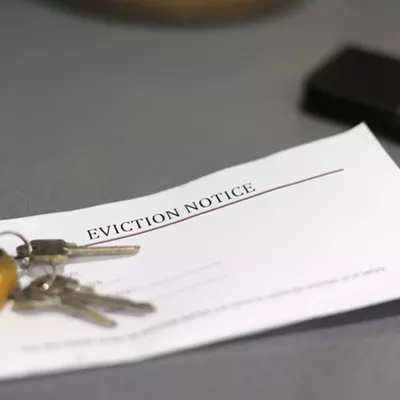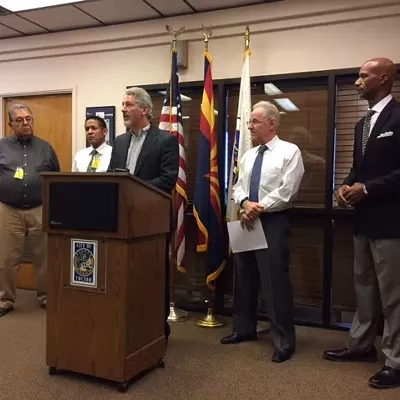Three bucks.
Credit Dan Eckstrom, the former longtime Democratic member of the Board of Supervisors who still wields wide power, for planting regular folk at Rigo's among bureaucrats, county bond backers and speculators.
Still, left from the enormously popular buffet were those bearing the burden: Pima County property owners saddled with chronic high taxes that have long been the highest of Arizona's 15 counties.
County Administrator Chuck Huckelberry touted the county's ability to market the bonds, such as the $174 million in debt that voters--with 20 percent turnout--overwhelmingly approved last year for open space. Huckelberry said the county would be able to do better than its pledge to keep the tax rate charged to pay off most bonds to less than $163 a year for the owner of a $200,000 home. That, he noted, was made possible by astoundingly good interest rates at which county bonds were sold at public auction, including the $50 million sold May 10 at 3.97 percent.
Such good fortune is enabling the county to reduce the category of taxes for bond repayment from 81.5 cents per $100 of assessed value by a dime on the rate, adding up to $20 for that $200,000 home (based on the residential tax ratio of 10 percent). That dime is being chopped by 6.5 cents included in a county library tax increase, needed to begin the county's five-year takeover of the Tucson-Pima Library System that has been run by the city and supported with county and city money. And finally, Huckelberry added Mount Lemmon projects that will require two more pennies from the proposed 10-cent cut.
That leaves the taxpayer with a 1.5-cent cut in the rate. It is a cut that will be meaningless when tax bills begin to arrive around Labor Day, because property values, the other component to tax bills, rose at far greater rates.
But taxpayers are still paying more--much more. The slight reduction in the debt category of property taxes, and there are five county tax categories, arrives chiefly because of growth. That means growth in new homes and new commercial buildings and growth in the value of properties.
The net assessed value for Pima County rose 8.4 percent, to $5.8 billion, Huckelberry noted in his budget overview presented last month to the Board of Supervisors. More than half of the increase comes from the increase in values to existing homes and other property.
So even with a tax cut that the Board of Supervisors is poised to embrace, the county will be able to boost its debt-retirement budget by $5.7 million to $67.7 million.
Democrats controlling the Board of Supervisors have repeatedly boasted that they have kept property tax rates stable or constant. But that has done nothing for taxpayer relief.
Asked about cutting taxes the day after the rally at Rigo's, Ramon Valadez, the Democrat who succeeded Eckstrom in the southside district, snapped that it was impossible because of "the cost transfers from the state and federal governments."
The county's primary tax rate, used to fund daily operations, has held at $4.07 per $100 of assessed value since the Board of Supervisors jacked it up with an 11 percent increase to that historic high in 1999. On a $200,000 home, that means $814 a year in gross primary taxes to the county, part of an overall $1,099 county tax bill.
The stagnant $4.07 rate has still meant a steady increase in cash. Since 1999, the primary tax levy--the maximum amount that could be hauled in from taxpayers--has soared 40 percent from $157 million to $220.4 million. The county's total levy, including for flood control taxes ($71 on a $200,000 home), library ($42.50 on a $200,000 home) and debt ($163 on a $200,000 home), jumped from $214.8 million in 1999 to $298 million this year, a nearly 39 percent increase.
Mary Schuh is the president of the Pima Association of Taxpayers; she's attuned to tricks hidden in the pledges of county tax cuts or tax stabilization. Since 1999, the Riverside Terrace home she and her husband, James, own has risen nearly 50 percent in tax value from $102,626 to $152,536. So while the county kept its operations budget tax rate at $4.07, the Schuhs are paying $204 a year more--$621, up from $417.
"Many of us on fixed incomes fight," said Schuh, who has long blasted county and other officials in colorfully scathing and well-researched statements at budget and tax hearings. "Some must have an unending supply of money, because they don't fight."
That fight can include appealing the value of property set by Pima County Assessor Bill Staples, a Democrat, and his staff.
Her association has sponsored workshops on value appeals, and Schuh said "some people are borrowing money to pay property taxes. When you are on a fixed income, any increase can mean whether you have a roof over your head or not."
Bill Heuisler, the Republican who lost to Staples last November, advocated fundamental changes that would have attempted to retard the effect the hot real estate market has on longtime residents. Heuisler would not have automatically raised someone's value when a neighbor sold at a high price.
"After the election, I guessed people just didn't care about property taxes as much as I thought they did," Heuisler said. "But then when I talk with people, they say they didn't understand that the sale of a home in their neighborhood affected theirs."
Second, Heuisler said, is that homeowners with mortgages simply "don't make the connection. They pay more, but they believe it has something to do with increased mortgage costs. Politicians have the best of both worlds here. They are able to raise taxes, the amount in tax bills, and most people don't know, because they are paying taxes through their mortgage, and they think it's some sliding thing where it is going up. I'd like to see some way to make it clear for people, that there is an increase because the tax bills increase."










